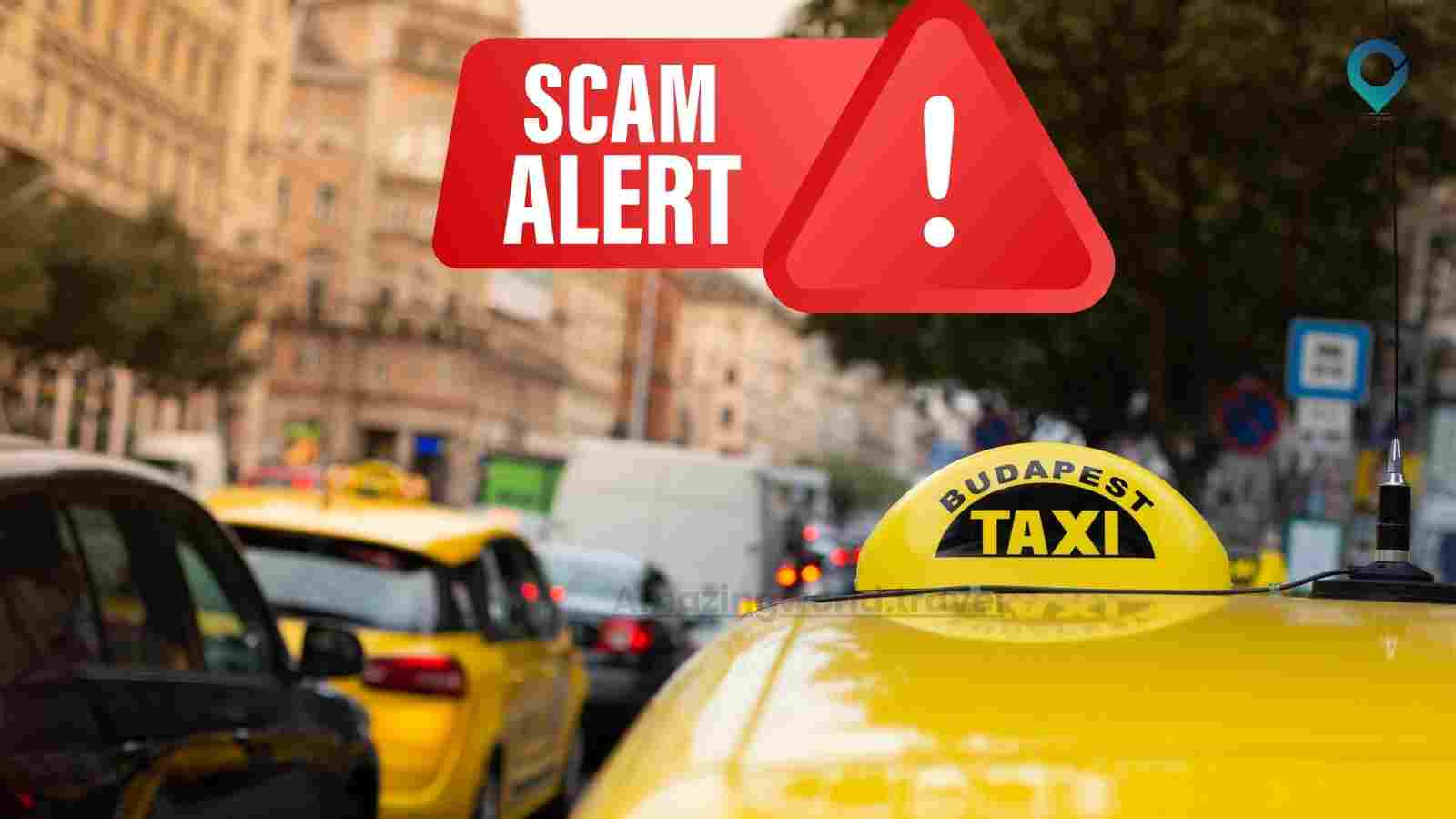How to spot and avoid the fake taxi scam

Are you an avid traveler eager to explore new destinations? As you embark on your journeys, one vital aspect to consider is ensuring your safety, especially when it comes to navigating unfamiliar places and avoiding potential scams. One significant concern for travelers worldwide is encountering fake taxi drivers.
These impostors often lurk around transportation hubs, waiting to take advantage of unsuspecting tourists. In this guide, we will unravel the secrets to staying safe and sidestepping fake taxi drivers, all while enjoying your travels to the fullest.
Let’s delve into the world of travel safety and discover how to protect yourself from these dubious characters.
Looking for the best Car Rental service for your next travel Jouney? Therefore, we recommend you book your car rental from DiscoverCars.com – Official Website
What Are Fake Taxi Drivers?
Fake taxi drivers are individuals who operate vehicles that resemble traditional taxis but do not possess the necessary permits or licenses to provide taxi services legally. These impostors often aim to exploit travelers, and their motivations can vary. Some fake taxi drivers are primarily driven by financial gain, overcharging passengers, or employing dishonest pricing tactics. Others, more alarmingly, engage in criminal activities, putting passengers at risk of theft, fraud, or more serious crimes.
What makes fake taxi drivers particularly risky is their lack of accountability, as they operate without proper licensing or oversight, making it challenging to hold them responsible for their actions. Travelers encountering fake taxi drivers may face overcharging, safety concerns, and even legal issues, making it essential to be aware of these risks and take precautions when seeking transportation in unfamiliar areas.
To stay safe, travelers should research reputable transportation options and learn how to identify legitimate taxi services, ensuring a safer and more pleasant travel experience.
The Pre-Travel Preparation
Preparing for your travels is a critical step in ensuring a safe and enjoyable journey. Before you embark on your adventure, take the time to plan and equip yourself with the knowledge and resources needed to navigate the potential challenges of encountering fake taxi drivers. Here’s how to prepare effectively:
Research Your Destination: Begin by researching your destination thoroughly. Understand the local transportation options available, including official taxi services, public transit, and ride-sharing apps. Knowing what to expect in advance can help you make informed choices.
Identify Reputable Taxi Companies: Look for well-established and reputable taxi companies operating in the area you’ll be visiting. Read reviews, check online forums, and ask for recommendations from fellow travelers or local contacts. Reliable taxi services often have a strong online presence and positive customer feedback.
Download Transportation Apps: In today’s digital age, numerous transportation apps can make your travel experience more convenient and safer. Download apps for booking official taxis or rideshares that are widely used and trusted in your destination.
Know the Local Rates: Familiarize yourself with local taxi fare rates or estimates. Being aware of typical pricing can help you spot overcharging attempts by fake taxi drivers. Some destinations have fixed rates from airports to city centers, which can also be beneficial to know.
Learn Common Scams: Research common taxi scams specific to your destination. Awareness of these scams, such as rigged meters or fake “official” taxi signs, can help you recognize fraudulent practices.
Emergency Contacts: Save emergency contact numbers for local authorities and your country’s embassy or consulate in your destination. In case of any issues with transportation, you’ll have a resource to turn to for assistance.
Share Your Plans: Inform a trusted friend or family member about your travel plans, including your expected arrival time and transportation details. This ensures someone knows your whereabouts and can help in case of emergencies.
Pack Light and Stay Alert: When you arrive at your destination, keep your belongings secure and readily accessible. Avoid displaying valuable items that might attract unwanted attention. Stay vigilant when exiting an airport or transportation hub, as fake taxi drivers often target tired or disoriented travelers.
Pre-travel preparation is a vital aspect of staying safe while traveling. By arming yourself with knowledge, reputable transportation options, and awareness of potential scams, you can minimize the risks associated with fake taxi drivers and enhance your overall travel experience.
Official Taxi vs Fake Taxi: Key Differences
When you’re in an unfamiliar destination and need transportation, distinguishing between official taxis and fake taxis is essential for your safety and financial well-being. Understanding the key differences between the two can help you make informed choices:
Licensing and Identification
Official Taxis: Official taxis are typically licensed by local authorities. They have visible identification, which may include a prominently displayed taxi license number, official logos, and markings on the vehicle.
Fake Taxis: Fake taxis often lack proper licensing and identification. They may have makeshift or no markings, making it difficult to verify their authenticity.
Metered Pricing
Official Taxis: Legitimate taxis usually have working meters that calculate fares based on distance and time. This transparent pricing system ensures you pay a fair and standardized rate.
Fake Taxis: Fake taxi drivers may refuse to use meters or have rigged meters that charge exorbitant fares. They may also quote arbitrary prices, leaving passengers vulnerable to overcharging.
Uniforms or Dress Code
Official Taxis: In many places, official taxi drivers wear uniforms or dress professionally. Their attire helps passengers recognize them easily.
Fake Taxis: Fake taxi drivers may not adhere to any dress code, making them less identifiable as service providers.
Vehicle Condition
Official Taxis: Legitimate taxis are often well-maintained and regularly inspected for safety. They should be clean and in good working order.
Fake Taxis: Fake taxi vehicles can vary widely in condition. Some may be poorly maintained or even unsafe to ride in.
Prebooking and Dispatch
Official Taxis: Many official taxi services offer the option to prebook a ride through a reputable taxi company or app, providing passengers with a reliable and secure way to arrange transportation.
Fake Taxis: Fake taxi drivers usually do not offer pre-booking services through official channels. Instead, they rely on hailing passengers on the street or approaching them at transportation hubs.
Knowledge of Local Routes
Official Taxis: Legitimate taxi drivers typically have a good knowledge of local routes, landmarks, and destinations. They can provide valuable information to passengers.
Fake Taxis: Fake taxi drivers may lack this local knowledge, potentially leading to longer routes, increased fares, or confusion.
Recognizing these key differences is crucial for your safety and financial security while traveling. To avoid falling victim to fake taxi scams, it’s essential to be vigilant, look for proper identification, insist on metered fares where applicable, and choose reputable transportation options whenever possible. By doing so, you can ensure a safer and more enjoyable travel experience.
Research and Booking Apps

In the digital age, research and booking apps have revolutionized the way travelers plan and execute their journeys. When it comes to identifying safe and reliable transportation options while traveling, these apps can be invaluable. Here’s how research and booking apps can enhance your travel experience:
Access to Information: Research apps provide travelers with comprehensive information about local transportation services, including official taxi companies, public transit options, and ride-sharing services. You can access details such as fare estimates, service availability, and user reviews.
Booking Convenience: Many apps allow travelers to book transportation services in advance, providing peace of mind and reducing the stress of finding a ride upon arrival. This is particularly helpful in areas where transportation demand is high.
User Reviews and Ratings: User-generated reviews and ratings on these apps offer valuable insights into the quality and safety of transportation providers. Reading other travelers’ experiences can help you make informed decisions and avoid potential scams.
Transparent Pricing: Booking apps often provide transparent pricing information, so you can estimate the cost of your journey in advance. This helps prevent surprise overcharges by taxi drivers or other transportation providers.
Safety Features: Some apps incorporate safety features, such as tracking your ride in real-time, sharing your trip with friends or family, and contacting emergency services if needed. These features add an extra layer of security to your travel experience.
Language Support: Travel apps often support multiple languages, making it easier for international travelers to navigate and use transportation services in foreign destinations.
Payment Options: Many apps offer multiple payment options, including cashless transactions, which can be particularly useful when traveling abroad and dealing with unfamiliar currencies.
Airport and Transportation Hubs
Airports and transportation hubs are often the first points of contact for travelers when arriving at a new destination. They can also be hotspots for encounters with fake taxi drivers and other transportation scams. Here’s how to navigate these areas safely:
Use Official Taxi Stands: Many airports have designated taxi stands where you can find legitimate taxi services. These taxis are often regulated and monitored by airport authorities, reducing the risk of encountering fake drivers.
Avoid Solicitation: Be cautious of individuals approaching you inside the airport or transportation hub and offering taxi services. Instead, seek out the official taxi stand or use reputable transportation apps.
Know the Approximate Fare: Before leaving the airport, inquire about the approximate fare to your destination from the information desk or official taxi stand. This will give you an idea of what to expect and help you identify overcharging.
Verify the Driver’s Identity: Ensure that the driver matches the photo and details provided by the taxi booking app if you’ve made a reservation. This can help you confirm that you’re getting into the correct vehicle.
Traveling Late at Night: If you arrive late at night, exercise extra caution. It’s advisable to book transportation in advance or arrange for airport-approved transfer services to avoid potential safety issues.
By utilizing research and booking apps, as well as following safety precautions at airports and transportation hubs, travelers can significantly reduce the risk of encountering fake taxi drivers and enjoy a smoother and more secure transition into their destination. These practices contribute to a safer and more enjoyable travel experience overall.
Identifying Fake Taxi Drivers

When it comes to identifying fake taxi drivers, paying attention to specific signs and behaviors can help you differentiate between legitimate and fraudulent transportation providers. Here are some key points to consider:
Lack of Proper Identification: Fake taxi drivers often lack visible identification, such as a taxi license number or official markings on their vehicles. Legitimate taxis typically display these identifiers prominently.
Refusal to Use the Meter: Fake taxi drivers may refuse to use the meter or insist on a fixed price, which can lead to overcharging. Legitimate taxi drivers should be willing to use the meter for transparency.
Unmarked or Unprofessional Vehicles: Fake taxis may use unmarked or poorly maintained vehicles, making them less identifiable as legitimate service providers. Official taxis usually have well-maintained vehicles with proper signage.
Aggressive Solicitation: Be wary of taxi drivers who aggressively approach you at airports or transportation hubs, especially if they are not waiting at official taxi stands. Official taxis are often found at designated locations.
Inconsistent Uniforms or Attire: Fake taxi drivers may not adhere to any dress code or uniform, while official taxi drivers in some regions wear uniforms or professional attire.
What to Do When You Encounter a Fake Taxi
Encountering a fake taxi can be concerning, but knowing how to respond can help you navigate the situation safely and effectively. Here’s what to do when faced with a potentially fake taxi driver:
Stay Calm and Assess the Situation: Keep your composure and assess the situation. Verify the driver’s identification and the condition of the vehicle discreetly.
Refuse the Ride: If you suspect you are dealing with a fake taxi, it’s safest to decline the ride and look for an official taxi or use a reputable transportation app.
Seek Help: If you feel threatened or uncomfortable, seek assistance from airport or transportation hub staff, security personnel, or nearby authorities.
Take Photos and Notes: If you can do so safely, take photos of the vehicle, license plate, and driver. Make mental notes of any distinctive details that could be useful for reporting the incident.
Contact Local Authorities: If you believe you’ve encountered a fake taxi, report the incident to local law enforcement or the relevant authorities. Providing them with information can help address the issue.
Share Your Experience: Consider sharing your experience and any photos on travel forums or apps to warn fellow travelers and seek advice.
Learn from the Experience: Use the encounter as a learning experience. Take note of what raised your suspicions and apply this knowledge to future travels to avoid similar situations.
Local Insights and Advice
When it comes to staying safe while traveling and avoiding encounters with fake taxi drivers, one invaluable resource is the local insights and advice provided by residents and experienced travelers. Here’s why seeking local insights and advice is crucial and how to go about it:
- Local Knowledge: Locals have a deep understanding of their city or region, including transportation options, common scams, and areas to be cautious about. Their insights can be invaluable in helping you navigate safely.
- Cultural Awareness: Locals can provide cultural insights that are essential for respectful and safe interactions. Understanding local customs and etiquette can prevent misunderstandings and potentially risky situations.
- Recommendations: Local residents and experienced travelers can recommend reputable taxi services, transportation apps, and other safe means of getting around. Their recommendations are often based on personal experience.
- Avoiding Tourist Traps: Locals can advise you on how to avoid tourist traps and areas where fake taxi drivers tend to operate. They can also recommend less crowded and safer transportation options.
- Emergency Contact Information: Locals can provide you with important contact information for local authorities, taxi regulators, or organizations that can assist you in case of any transportation-related issues.
Here’s how to seek and make use of local insights and advice:
- Interact with Locals: Engage in conversations with local residents, hotel staff, or restaurant workers. They can often provide valuable tips and recommendations.
- Join Online Travel Communities: Online travel forums and social media groups focused on your destination can be excellent sources of advice. Experienced travelers and locals frequently share their insights and answer questions.
- Ask for Recommendations: When you arrive at your destination, don’t hesitate to ask for recommendations for safe transportation. Hotel concierges and front desk staff are usually knowledgeable about reputable taxi services.
- Language Assistance: If you’re not proficient in the local language, consider using translation apps or services to help facilitate communication when seeking advice from locals.
- Stay Informed: Keep up-to-date with local news and travel advisories. Sometimes, emerging issues or safety concerns related to transportation are reported in the news.
- Online Reviews: Read online reviews for transportation services and apps. While you should take individual reviews with a grain of salt, patterns of positive or negative feedback can provide insights.
- Local Apps: Some regions have specific transportation apps or services that may not be well-known to tourists. Locals can inform you about these options.
By actively seeking and heeding local insights and advice, you can make more informed decisions about transportation, avoid potential scams, and enhance your overall travel experience. Remember that local knowledge is often your best defense against encountering fake taxi drivers and other travel-related issues.
Conclusion
Ensuring your safety while traveling and avoiding fake taxi drivers is paramount. Throughout this guide, we’ve explored essential strategies and insights to help you navigate unfamiliar destinations securely.
Understanding what fake taxi drivers are and why they pose a risk is the first step. Preparing before your trip by researching your destination, identifying reputable taxi services, and using travel apps for booking and information can significantly enhance your safety.
Distinguishing between real and fake taxis is crucial. Look for proper identification, the use of meters, uniforms or dress codes, well-maintained vehicles, and professional behavior from drivers.
Travel apps can be your allies, providing information on transportation options, transparent pricing, user reviews, and safety features. At airports and transportation hubs, stick to official taxi stands, avoid solicitation from strangers, know typical fares, and take extra precautions, especially when arriving late at night.
Knowing how to identify fake taxi drivers is vital. Be cautious of a lack of proper identification, refusal to use meters, unprofessional vehicles, aggressive solicitation, and inconsistent attire.
If you suspect you’ve encountered a fake taxi, keep calm, decline the ride, seek help, document the situation, contact local authorities, and share your experience to warn others.
Local insights and advice can be invaluable. Tap into the knowledge of locals and experienced travelers for recommendations, cultural awareness, and emergency contact information.
How much did you like Our Detailed How to spot and avoid the fake taxi scam? Review Also, please share these Blogs with your friends on social media.
Recommended
- Taxi scams in the USA and Europe
- 10 Common Taxi Scams and How to Avoid Them
- 10 Essential Taxi Safety Tips

Meet David Hoper, a passionate travel Blog writer with 7+ years of experience in travel content. Through his exemplary storytelling and engaging narratives, he shares his experiences and brings destinations to life. With a keen eye for detail and a love for exploration, he has cultivated a diverse portfolio of travel blogs that inspire and inform readers worldwide.








